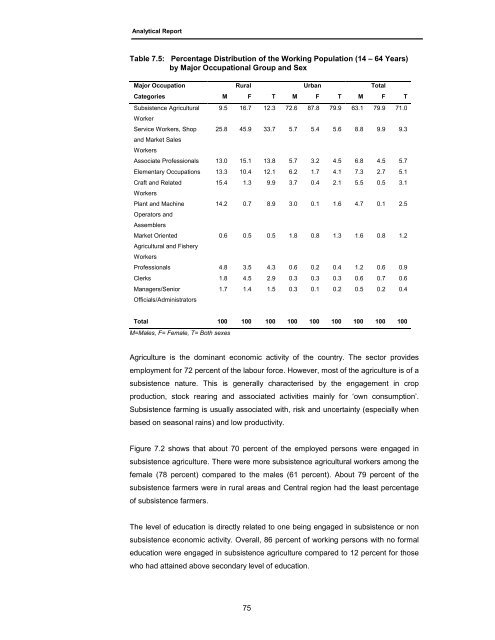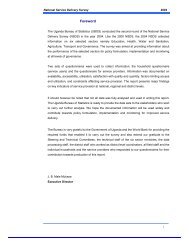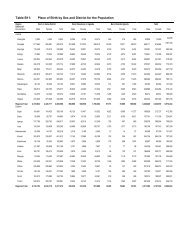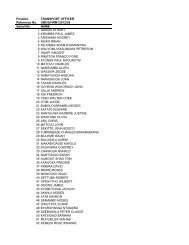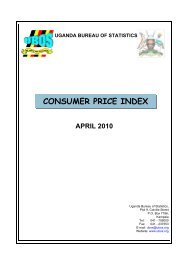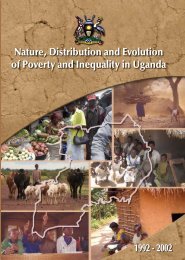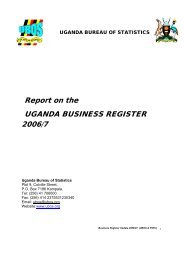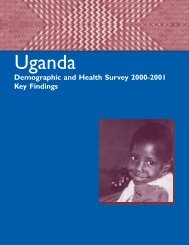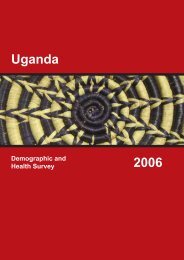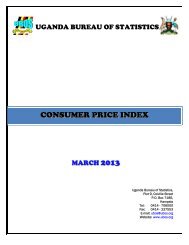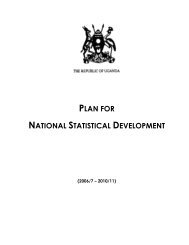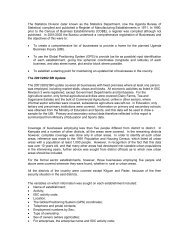Census Analytical Report - Uganda Bureau of Statistics
Census Analytical Report - Uganda Bureau of Statistics
Census Analytical Report - Uganda Bureau of Statistics
You also want an ePaper? Increase the reach of your titles
YUMPU automatically turns print PDFs into web optimized ePapers that Google loves.
<strong>Analytical</strong> <strong>Report</strong>Table 7.5: Percentage Distribution <strong>of</strong> the Working Population (14 – 64 Years)by Major Occupational Group and SexMajor Occupation Rural Urban TotalCategories M F T M F T M F TSubsistence Agricultural 9.5 16.7 12.3 72.6 87.8 79.9 63.1 79.9 71.0WorkerService Workers, Shop 25.8 45.9 33.7 5.7 5.4 5.6 8.8 9.9 9.3and Market SalesWorkersAssociate Pr<strong>of</strong>essionals 13.0 15.1 13.8 5.7 3.2 4.5 6.8 4.5 5.7Elementary Occupations 13.3 10.4 12.1 6.2 1.7 4.1 7.3 2.7 5.1Craft and Related15.4 1.3 9.9 3.7 0.4 2.1 5.5 0.5 3.1WorkersPlant and Machine14.2 0.7 8.9 3.0 0.1 1.6 4.7 0.1 2.5Operators andAssemblersMarket Oriented0.6 0.5 0.5 1.8 0.8 1.3 1.6 0.8 1.2Agricultural and FisheryWorkersPr<strong>of</strong>essionals 4.8 3.5 4.3 0.6 0.2 0.4 1.2 0.6 0.9Clerks 1.8 4.5 2.9 0.3 0.3 0.3 0.6 0.7 0.6Managers/SeniorOfficials/Administrators1.7 1.4 1.5 0.3 0.1 0.2 0.5 0.2 0.4Total 100 100 100 100 100 100 100 100 100M=Males, F= Female, T= Both sexesAgriculture is the dominant economic activity <strong>of</strong> the country. The sector providesemployment for 72 percent <strong>of</strong> the labour force. However, most <strong>of</strong> the agriculture is <strong>of</strong> asubsistence nature. This is generally characterised by the engagement in cropproduction, stock rearing and associated activities mainly for ‘own consumption’.Subsistence farming is usually associated with, risk and uncertainty (especially whenbased on seasonal rains) and low productivity.Figure 7.2 shows that about 70 percent <strong>of</strong> the employed persons were engaged insubsistence agriculture. There were more subsistence agricultural workers among thefemale (78 percent) compared to the males (61 percent). About 79 percent <strong>of</strong> thesubsistence farmers were in rural areas and Central region had the least percentage<strong>of</strong> subsistence farmers.The level <strong>of</strong> education is directly related to one being engaged in subsistence or nonsubsistence economic activity. Overall, 86 percent <strong>of</strong> working persons with no formaleducation were engaged in subsistence agriculture compared to 12 percent for thosewho had attained above secondary level <strong>of</strong> education.75


